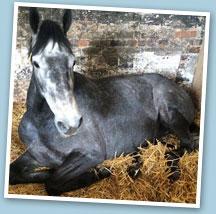
Preparing for surgery
Despite best efforts our equine partners can still be susceptible to illness and injury and throughout a horse’s life there are occasions when surgery may be necessary. Petplan Equine veterinary expert, Gil Riley discusses what is involved in preparing for surgery.
Surgical intervention maybe required in the treatment of a range of different conditions affecting horses, from emergency colic surgery to a planned operation to correct a conformational problem such as kissing spines or treatment for a traumatic injury for example. Equine surgery is not without its risks but the right preparation can help to make it go as smoothly as possible.
The day before surgery the horse is admitted to the clinic. A full clinical examination is performed ensuring there are no obvious health issues that would increase the risk of the surgical procedure being performed e.g. heart abnormalities or lung dysfunction. A full blood profile is also performed at this stage so that any problems not obvious externally e.g. any organ disorders or infections present, may be detected.
If all is in order the horse receives just a hay net the evening before the operation so that once this net is finished there will be no more food until after the operation. This is because general anaesthetic slows gut function and intake of food in the hours immediately before the operation can predispose to impaction colic in the 24 hours after surgery.
The morning of surgery:
- All of the shoes are removed if the horse is shod to help prevent self-injury on its awakening and damage to the recovery box.
- An area of the neck is clipped up and sterilized ready for an intravenous catheter to be inserted. This is where the anaesthesia is given.
- The anaesthesia is injected directly into the catheter so that the horse quickly and comfortably falls asleep. Antibiotics can also be administered via the catheter at this stage to prevent infection.
- Finally, the area to be operated on is clipped and cleaned. This means that when the horse undergoes anaesthesia, preparation of the area for surgery can be performed much more quickly and thus the total surgical time will be reduced. This is very important as safety of a general anaesthetic is very much related to the length of the surgical procedure.
After surgery, the horse is moved into the recovery box which is a room with padded floor and walls to minimize injury as the horse regains conscientiousness and attempts to get to its feet; a horse will usually have to attempt getting to its feet several times before remaining standing.



